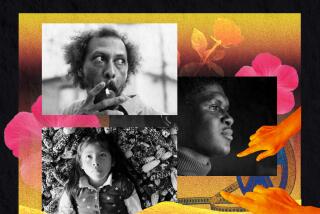Review: Eduardo Halfon’s moving ‘The Polish Boxer’
The Polish Boxer
Eduardo Halfon
Translated from the Spanish by Daniel Hahn, Ollie Brock, Lisa Dillman, Thomas Bunstead and Anne McLean
Bellevue Literary Press: 188 pp., $14.95 paper
In the closing pages of “The Polish Boxer,” a book that willfully and delightfully blurs the boundaries among novel, memoir and meditation, Guatemalan writer Eduardo Halfon exposes what he, what any author, is up against. “Literature,” he explains, “is no more than a good trick a magician or a witch might perform, making reality appear whole, creating the illusion that reality is a single unified thing.”
The implication is that writing is a shell game, in which we arrange odd bits of imagination or experience until they seem to cohere. This coherence is an illusion, a story we tell ourselves to rein in (or protect against) the chaos of the world.
“The Polish Boxer” is the first book of Halfon’s to be translated into English, and it is all about that contradiction: How do we make meaning when meaning eludes us at every turn? Composed of 10 loosely knit chapters (or stories), it is narrated by a writer named, yes, Eduardo Halfon, although whether this is the author is a question the book leaves unresolved.
On the one hand, Halfon shares many of the attributes of his creator — an apostate Jew, educated (in engineering, of all things) in the United States, a professor at Guatemala’s Francisco Marroquín University. He now lives in Nebraska and received a 2011 Guggenheim to work on a follow-up to “The Polish Boxer.” And yet, throughout this book, both narrator and author go out of their way to destabilize us, suggesting that stories are both about obscuring and revealing.
“[A] story always tells two stories,” Halfon tells us in the opening chapter, quoting from an essay he has assigned to a classroom of bored undergraduates, “… the visible narrative always hides a secret tale.”
Indeed, “The Polish Boxer” weaves this idea into its very fiber. At the center of the book is the narrator’s grandfather, a concentration camp survivor who tells his grandson, then a young boy, that the string of digits tattooed on his left forearm is his phone number, inscribed so he will not forget. Eventually, the grandfather tells a different story: He was saved in Auschwitz by a boxer from his village in Poland who coached him on how to survive.
Whether this is true is the secret tale of “The Polish Boxer”; Halfon locates the saga of his grandfather in the exact middle of the book. That creates an interesting tension, since, title aside, the book is not really about the grandfather. In fact, his story is among the least satisfying here: Fixed, distant, uneventful, it never fully resonates. And yet, this is part of the point, for both the narrator and his grandfather, as Halfon makes clear when, at the end of the book, he returns to the older man from a different angle, exposing a sharpness that the earlier telling lacks.
I’m being intentionally vague about the narrative, for a key pleasure of “The Polish Boxer” is that of revelation. As Halfon observes, “The why of an action is a kind of intellectual crossword, it occurred to me then or it occurs to me now, in which you try to fill in the little empty boxes that get tangled up with one another, that mix and lean into one another, in which no answer is worth more or less than any other and also where each answer might on its own seem irrational or even downright crazy. But when they are brought together, they complement and strengthen one another. Or something like that.”
All this comes together in another character, a half-Serbian, half-gypsy pianist named Milan Rakic with whom the narrator grows obsessed. Their relationship becomes a central focus of “The Polish Boxer” — especially after the narrator receives a series of cryptic postcards, which leads him to Belgrade, where he suspects the pianist has returned to his gypsy roots.
Like Halfon, Milan is caught between who he is and who he wants to be, seeking a reconciliation that he knows will not arrive. “Why create boundaries between genres?” he asks. “Why differentiate between one type of music and another? It’s all the same.”
Similar questions motivate the narrator, who wants to make an internal revolution, one of consciousness rather than of style. “[H]ow and why someone is pushed toward a revolution of the spirit, whether it be artistic or social or whatever, strikes me as a far more honest search than all of the spectacle that follows,” he argues. “Because everything after that … is pure spectacle. Painting a canvas? Spectacle. Writing a novel? Spectacle.”
That’s a self-reflective moment, in a book full of self-reflective moments. But the power of “The Polish Boxer” is that it is always rooted in the personal. It is deeply accessible, deeply moving, not least because everything it addresses — the fate of the pianist, the grandfather, the narrator’s identity — remains elusive.
“This is exactly what literature is like,” Halfon tells us. “As we write, we know that there is something very important to be said about reality, that we have this something within reach, just there, so close, on the tip of our tongue, and that we mustn’t forget it. But always, without fail, we do.”
More to Read
Sign up for our Book Club newsletter
Get the latest news, events and more from the Los Angeles Times Book Club, and help us get L.A. reading and talking.
You may occasionally receive promotional content from the Los Angeles Times.








